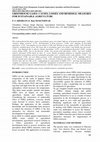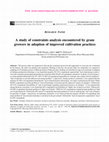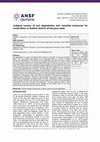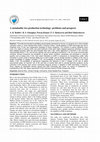Papers by padip shehrawat

Indian journal of applied research, 2016
The Agro-forestry systems in India include trees on farms, community forestry and a variety of lo... more The Agro-forestry systems in India include trees on farms, community forestry and a variety of local forest management and ethno forestry practices. In this era of global warming, fast degradation of land productivity and other environmental hazards, Agro-forestry is indeed a stake for natural resources and socioeconomic sustainability. The present study indicated that there were 54.2% of respondents found had most favorable attitude towards Agro-forestry. It was found that respondents have their own criteria for testing species suitable for improving soil fertility, availability of fodder, and fuel wood requirements. The study further indicated that a significant majority of the respondents had not adopted the recommended Agro-forestry practices. Therefore, it would be worthwhile for the government functionaries to organize training, demonstration and take up appropriate educational programs so that the respondents may loaded with required information and skills to adopt the new me...
Annals of Agri Bio Research, 2015

The result predicted that major causes of greenhouse gases were found ‘high use of inorganic farm... more The result predicted that major causes of greenhouse gases were found ‘high use of inorganic farm inputs’ (2.88), ‘intensive tillage practices’ (2.75), ‘mechanization of farm practices’, (2.66), ‘nonadoption of diversified agriculture’ (2.52), ‘non-adoption of crop rotation; (2.46), and ‘burning of crop residue in field’ (1.95) with their respective weighted mean scores. The losses due to greenhouse gases were found ‘crop benefit ratio decreased’ (1.23), ‘crop damaged due to adverse climatic uncertainty’ (1.07), ‘crop production decreased’ (0.89), ‘sowing season change (0.86), ‘loss in bio-diversity’ (0.84), ‘less income from agriculture’ (0.81), ‘soil water holding capacity decreased’ (0.68) based on their ‘Z’ scores. Results pertaining adoption of remedial measures for sequestration of greenhouse gases for sustainable agriculture were ‘evolution of new crops cultivars’ (2.95), ‘crop diversification’ (2.90), ‘use zero tillage practices’ (2.81) ‘integrated farming system’ (2.79) ‘ad...
Indian journal of applied research, 2016
The study focused on adoption of masumbi cultivation practices in the state. Fruit have great imp... more The study focused on adoption of masumbi cultivation practices in the state. Fruit have great importance in human dietary system and it is generally stated that the living standard of people can be judged by the production as well as consumption of fruits. 70.84 per cent of the farmers had medium to high level of adoption category. Time of planting, recommended cultivators, fruit drop were highly adopted agronomic practices, whereas least adopted agronomic practices were packaging, disease and their control and insect pest and their control.
Annals of Agri Bio Research, 2015
The traditional method of irrigation practised from time immemorial in the world is surface runof... more The traditional method of irrigation practised from time immemorial in the world is surface runoff and depercolation. No basic change has been taken place in surface method of water application over the years. Sprinkler system of irrigation comes into existence over 55 year back. In recent years sprinkler method of irrigation has become more popular particularly, in the areas where water is a limiting resource.

Indiais the largest producer of vegetables in the world next to China; its requirements of vegeta... more Indiais the largest producer of vegetables in the world next to China; its requirements of vegetables are rapidly increasing because of burgeoning population. The factors such as adverse climatic conditions, high potential of vegetables, fruits and flowers, agro inputs availability, small and fragmented land holdings and increased demand of quality vegetables necessitate the adoption of protected cultivation. Multiple cropping on the same piece of land, increased production and productivity per unit of land, water, energy and labour, high quality and clean products, high water and fertilizer use efficiency, subsidy provision for establishment of high cost infrastructure, round the year employment to the farmers were the major prospective aspects perceived by poly house farmers. While they facedthe problems like population explosion of minute insects like mites & white flies, especially the white fly menace, poor quality of cladding material, frequent occurrence of windstorms, hails...

The study was conducted in two districts of Haryana state namely; Hisar and Sonipat, and a total ... more The study was conducted in two districts of Haryana state namely; Hisar and Sonipat, and a total no. of one hundred twenty farmers were selected and interviewed with the help of well structured schedule. The study revealed that awareness about the utilization of biogas plant waste, mushroom waste, wheat waste, mustard and horticultural waste was more than 70 percent. Thus, overall awareness about utilization of agricultural waste was very high but utilization of agricultural waste by the farmers was very less. Results pertaining to benefits to farmers after utilization of agricultural waste revealed that most of the farmers were benefited in very ordinary ways like high milk yield, addition income by selling waste to brick yards, reduced expenditure on chemical fertilizers, reduced waste available for disposal, clean and safe environment, etc. Employment opportunities will increase if industries like processing units for making value added products, handicrafts industries for making...

Journal of Environmental Biology
Aim: To study different complementary practices like zero tillage, agroforestry, crop diversifica... more Aim: To study different complementary practices like zero tillage, agroforestry, crop diversification etc., adopted for conservational agriculture. Methodology: The study was conducted in the year 2018 in Haryana state of India, which is divided into two agro-climatic zones, i.e., North-Eastern Zone and South-Western Zone. A total of 240 respondents were personally interviewed for the present study. Results: The farmers were highly aware of the fact that the zero tillage reduces the field preparatory cost, agroforestry provides healthy environment and extra income whereas crop diversification reduces the risk of crop failure. Major constraints in zero tillage, agroforestry and crop diversification were ?straw burning?, ?lack of interest among respondents due to long duration of return? and ?lack of educational and training facilities?, respectively. Interpretation: Conservation agriculture opens new doors towards mitigating the effects of conventional agricultural systems and to imp...
International Journal of Current Microbiology and Applied Sciences, May 10, 2018

INTERNATIONAL JOURNAL OF AGRICULTURAL SCIENCES
The present study was proposed to find out the constraints perceived and suggestions to overcome ... more The present study was proposed to find out the constraints perceived and suggestions to overcome the constraints by the farmers, the study was planned and conducted. Working to this fact, the present study was undertaken on a purposive sampling of 120 chickpea growers of Bhiwani district of Haryana state. Findings revealed that in respect of constraints in adoption of chickpea production technology, it was found that majority (99.33%) respondents reported that "lack of promising varieties" was main constraint among input and production constraint while 98.66% of respondents considered "incidence of weed menace" as serious problem followed by 98.33%, 98%, 97.66% of respondents had problem of "moisture stress under rain fed conditions", "lack of nutrients in soil and sufficient soil testing facilities", respectively. Among technical constraints, it was reported that the majority (91.66%) of respondents found that the "lack of demonstration and training" was major constraint faced by them. While 88.66% respondents faced the problem of "lack of knowledge on location specific improved varieties of chickpea", followed by (69.33%) respondents had problem of "lack of knowledge regarding agronomical practices of chickpea". It was reported that among financial constraints, it was found that 88% respondents faced problem of "higher rate of interest on loans" followed by (64.66%) respondents had major problem of "high cost of labour". While 64.33% respondents considered major problem of "high cost of agrochemicals" followed by 48% and 47% respondents had major problem of "lack of credit facility" and "lack of finance for purchase of inputs", respectively. In marketing constraints, it was observed that the majority (96.66%) of respondents had major problem of "procurement of produce is not done by the government" followed by "lack of cooperative organization" faced by 66% respondents.

Journal of Applied and Natural Science
Soil degradation is a point of evolution which leads to a reduction of resource potential. About ... more Soil degradation is a point of evolution which leads to a reduction of resource potential. About 7.40 m ha arable lands globally turn to degraded lands as a result of climate change and deforestation. The problem of soil degradation has been ever since cultivation of soils started because of increasing population of India at the rate of about 1.8% requiring marginal areas to be brought under the plough to meet the growing food demand. The present study was conducted in Kaithal district in the year 2018-19. The study revealed that ‘Excessive use of chemical fertilizers’ (88.33%) followed by ‘non- judicious use of insecticides/pesticides’ (85.83%), ‘less application of organic manure’ (85.00%), ‘deforestation (78.33%), and ‘over uplifting of ground water’ (75.83%) were found as most important causes of soil degradation. The most important remedial action for problematic soil were found as ‘land for equal distribution of resources/irrigation’ (90.83%) followed by ‘application of Gypsu...

Journal of Applied and Natural Science
The study has focused on problems and prospects perceived by farmers’ for growing rice in direct ... more The study has focused on problems and prospects perceived by farmers’ for growing rice in direct seeded cultivation mode i.e. Direct Seeded Rice (DSR) in Haryana (India). Overall adoption of DSR technology was low to moderate since 70 per cent respondents belonged to these categories. The method of sowing (weighted mean score 3.0), depth of sowing (2.93) and seed treatment (2.93) were highly adopted agronomic practices, whereas least adopted practices were like recommended seed rate (1.94), timely application of fertilizers (1.87) and their recommended doses (1.73), and ferrous sulphate use only at deficiency syndrome (1.19) not as per recommended schedule. Among constraints non-availability of quality seeds, fertilizers, weedicides and pesticides in required quantity and at proper time (1.64), high weed infestation in DSR in comparison to transplanting (2.88), wide fluctuation in prices (2.83) of basmati paddy due to lack of MSP, lack of storage facilities in villages (2.78), lack ...










Uploads
Papers by padip shehrawat